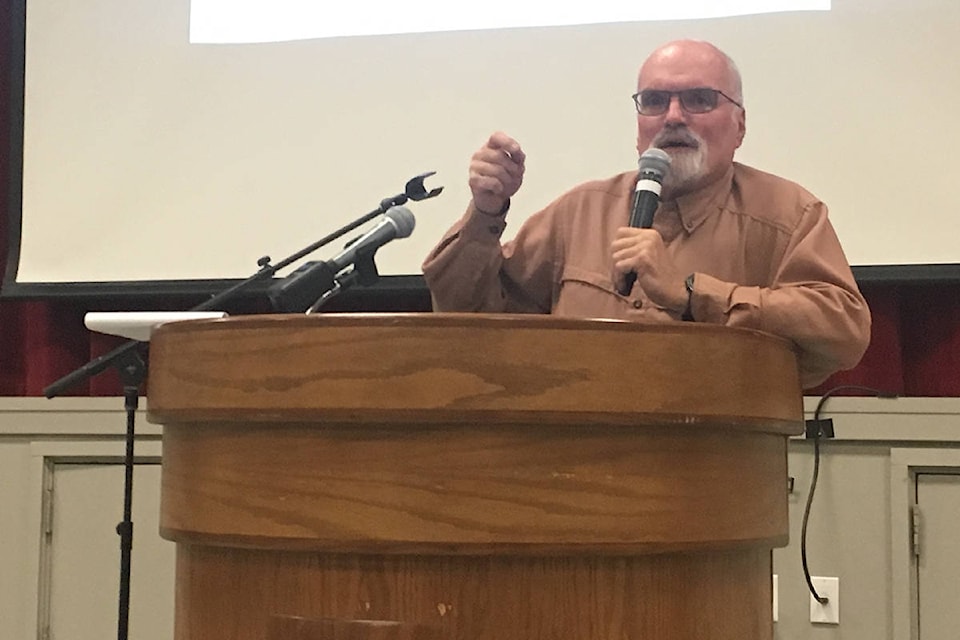Work continues on how to bring salmon back to the Columbia River.
Back in July, the five governments of the basin signed the Salmon Letter of Agreement, agreeing to work together to attempt to bring salmon back to the headwaters of Columbia Lake.
“A piece of paper doesn’t sound all that exciting, but a piece of paper which says ‘okay, now these five governments are going to work together’…[is significant progress],” said Bill Green, who has been working on bringing the salmon back for 25 years.
READ MORE: First Nations, governments agree to bring salmon back to Upper Columbia River
| Spring Chinook salmon. (COURTESY PHOTO, Michael Humling, US Fish & Wildlife Service) |
He said that one of the most pleasing things about the recently signed agreement is that there was recognition that the project needs to be Indigenous lead and guided by Indigenous principals as well as the United Nation’s Indigenous rights declaration.
The three year agreement, to which $2.25 million has been allocated, will see the Government of Canada, the Government of B.C., the Okanagan Nation Alliance, the Ktunaxa Nation Council and the Secwepemc Nation Tribal Council, will explore feasibility, put together a strategic direction and work through questions such as cost and desirability.
One obstacle for getting the salmon from the ocean to the headwaters, is their passage through the USA.
“We can’t do it single-handedly on the Canadian side,” said Green.
READ MORE: 23 projects get cash to help restore B.C.’s fragile salmon stocks
Our neighbours to the south have questions that need answering, such as how much habitat will be impacted as well as if the fish can be reintroduced into Slocan as part of the project.
Some of the bigger hurtles that Green has been working on are how to get the salmon over the dams, how to get the smolts back to the ocean and whether or not they will survive along the way.
“There is remarkable technological developments that are happening to support all this work,” he said.
One such technology is Whoosh, which has successfully been used to fire fish over a 300 ft. dam, Green said.
Another is a floating surface collector, which attracts and captures smolts so they can be safely transported downstream past the dam.
According to Green the first step will be reintroduction in the Trans Boundary Reach. Scientists on both sides of the border both agreed that a particular fish would likely be successful in those habitats.
“The problem comes, those fish are likely not the ones that are going to be successful all the way up to the headwaters,” he said. “We kind of have to do one step at a time and achieve success in the Trans Boundary Reach and then consider the next steps.”
Another concern for the feasibility of the project is keeping destructive fish such as pike and walleye out of the Arrow Lakes. Green said that regulated fish passage systems have been tested that sort the fish based on size, allowing the desirable species to cross the dam and not the others, but that is an ongoing obstacle to the project.
READ MORE: B.C. to be first to implement UN Indigenous rights declaration
Global warming has also been a part of the discussions. Luckily, if the temperature increase stays to two degrees or less, chinook will still likely be able to survive to make it to the headwaters.
“Of course if we don’t achieve the Paris accord, all bets are off across the spectrum,” Green said.
The potential for recovery would have a huge impact on the communities in the area. Green said that before the dams were built, around 80 years ago, Indigenous communities in the basin consumed 125,000-750,000 salmon and steelhead annually.
*With files by John Boivin
@JDoll_Revy
jocelyn.doll@revelstokereview.com
Like us on Facebook and follow us on Twitter.
